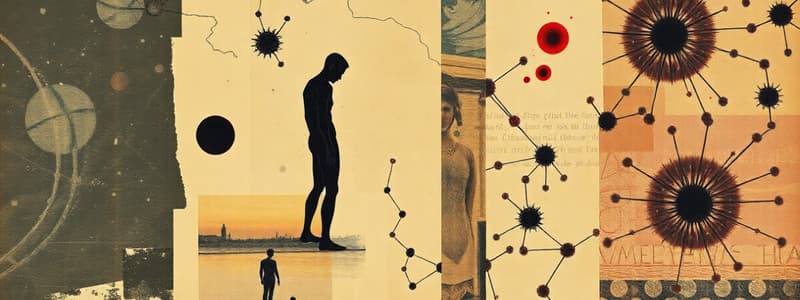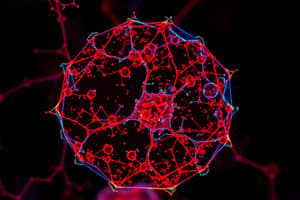Podcast
Questions and Answers
What initially sparked McCulloch's interest in researching the effects of radiation?
What initially sparked McCulloch's interest in researching the effects of radiation?
- A need to develop a marker technique for identifying cell colonies.
- A desire to understand the impact of radiation on bone marrow transplants.
- A curiosity about the effects of radiation on spleen nodule formation.
- An interest in the therapeutic potential of radiation for cancer treatment. (correct)
What surprising observation did McCulloch make during the autopsies of the mice?
What surprising observation did McCulloch make during the autopsies of the mice?
- The number of spleen nodules corresponded to the radiation dose.
- The number of spleen nodules was directly proportional to the number of surviving donor marrow cells. (correct)
- The spleen nodules contained a mixture of different cell types
- The spleens of the mice were significantly enlarged.
What specific technique did McCulloch and Till use to determine the origin of each spleen nodule?
What specific technique did McCulloch and Till use to determine the origin of each spleen nodule?
- They tracked the movement of individual cells from the bone marrow to the spleen.
- They analyzed the chromosomal composition of cells within the nodules. (correct)
- They used varying doses of radiation to create distinguishable cell markers.
- They injected a radioactive tracer into the donor cells.
What was the primary aim of McCulloch and Till's research involving bone marrow transplants in mice?
What was the primary aim of McCulloch and Till's research involving bone marrow transplants in mice?
What was the significance of the "colony-forming units" observed by McCulloch and Till?
What was the significance of the "colony-forming units" observed by McCulloch and Till?
How did Till and McCulloch confirm that each spleen nodule originated from a single cell?
How did Till and McCulloch confirm that each spleen nodule originated from a single cell?
What can be inferred about the nature of the cells that formed the spleen nodules?
What can be inferred about the nature of the cells that formed the spleen nodules?
What does McCulloch's description of their discovery as a "case study in serendipity" suggest about the research process?
What does McCulloch's description of their discovery as a "case study in serendipity" suggest about the research process?
What was the primary purpose of using varying radiation doses in the bone marrow transplants?
What was the primary purpose of using varying radiation doses in the bone marrow transplants?
How did the collaboration between McCulloch, a medical doctor, and Till, a physicist, contribute to their discovery?
How did the collaboration between McCulloch, a medical doctor, and Till, a physicist, contribute to their discovery?
Flashcards
Serendipity in research
Serendipity in research
The unexpected discovery of important scientific findings by chance.
Stem cells
Stem cells
Unique cells capable of self-renewal and becoming specialized types of cells.
McCulloch and Till's experiment
McCulloch and Till's experiment
Research exploring the effects of radiation on bone marrow cells in mice.
Bone marrow transplantation
Bone marrow transplantation
Signup and view all the flashcards
Colony-forming units
Colony-forming units
Signup and view all the flashcards
Spleen nodules
Spleen nodules
Signup and view all the flashcards
Marker technique
Marker technique
Signup and view all the flashcards
Single-cell cloning
Single-cell cloning
Signup and view all the flashcards
Types of blood cells
Types of blood cells
Signup and view all the flashcards
1961 publication
1961 publication
Signup and view all the flashcards
Study Notes
Major Breakthroughs in Science Involve Unexpected Findings
- McCulloch and Till's research in cellular biology and biophysics, in 1961, uncovered the first clue to stem cells
- These cells have a unique potential to become other specialized cells and can self-renew/multiply
- The discovery was unexpected, and described as a case study in serendipity
Unexpected Developments
- McCulloch, interested in the medical potential of nuclear radiation, wanted to study its effects on cancer cells
- This involved irradiating mice and measuring the radiation sensitivity of their bone marrow cells
- Replacing bone marrow cells with donor cells, while exposing the donor marrow cells to varying doses of radiation, was part of the experiment.
- The process of tracking the survival of donor marrow cells in the different radiation doses allowed researchers to measure how many marrow cells each mouse had received.
- Autopsies on the mice 10 days after transplants were conducted to further understand how the different radiation doses affected the transplanted marrow cells.
Colonies of Clones
- Till and McCulloch needed to determine if nodules developed from a single cell or multiple cells.
- They used irradiated donor cells to create a marker for identifying the original cells, and thus demonstrating that each nodule grew from a single cell.
- These original cells were referred to as “colony-forming units.”
- The colonies of cells within each nodule composed of a mixture of three blood cell types: red cells, white cells, and platelets.
Studying That Suits You
Use AI to generate personalized quizzes and flashcards to suit your learning preferences.




